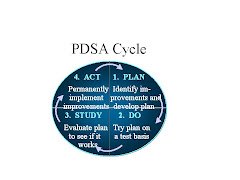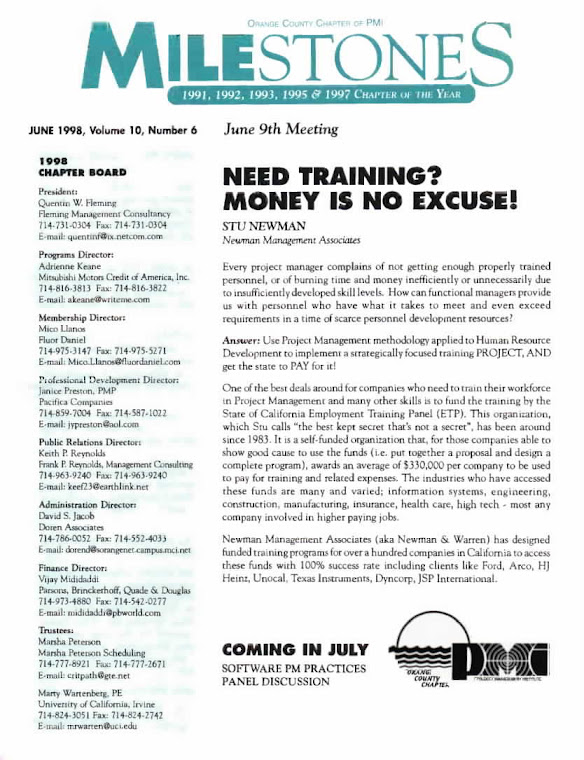Wednesday, December 23, 2009
PMP exam Lesson Learned (from Su Yin, 12/11/2009)
I'd like to give you an update on the PMP exam I took yesterday. I got an overall pass score based on the number of questions answered correctly, although the actual number or percentage was not provided. A second level of results was also reported with each of the six domains assigned one of the three levels of proficiency defined as follows:
Proficient - indicates performance above the average level of
knowledge
Moderately Proficient - indicates performance at the average level of
knowledge
Below Proficient - indicates performance below the average level of
knowledge
I got three Moderately Proficient and three Proficient ratings.
The "trickiness" of the questions was on par with the on-line and written sample questions and practice exams we have gone through in the class. The test time was abundant with an hour left after I went through the questions in a steady pace with an intent of not having to review and still feeling okay. The exam tips in Achieve PMP Exam Success captured all the key things to note for taking the exam.
Some logistics about the test center. Got there just before 8:30 am for the scheduled starting time of 9 am. The center was open already. Spent a few minutes to sign in and empty my pockets and roll up my sleeves to show nothing was stashed. Everything I had with me including the watch, keys, and secondary IDs had to go into a locker. Once into the test cubicle, 15 minutes was allowed to go through a tutorial to get familiarized with the setup. Once the test was over, an on-line survey showed up followed by the exam result. More than one type of exams is available at the center and the test scheduling must have been staggered since there was a constant stream of people coming in every half hour or so. Headsets were provided to minimize distraction.
Hope this info helps and gives you confidence that what we learned from the class was enough to get us pass the exam. Always enjoyed listening to and learning from the class discussions. Never failed to be amazed by how well many of you grasped the PM concepts and terminology. If I could pass the exam, you could too! Spending time reviewing the glossary and other materials definitely helps as well to build the margins and boost confidence.
Let me know if you have any questions.
Thanks,
Su
Earn PDU's for FREE
PMPs can earn PDU's for FREE
 To earn PDUs without spending money, there are Category 2 and Category 5 activities. Remember to have appropriate documentation for any PDUs.
To earn PDUs without spending money, there are Category 2 and Category 5 activities. Remember to have appropriate documentation for any PDUs.
Category 2 Activities: Category 2 offers a number of opportunities to claim PDUs based on your Professional Activities and Self-Directed Learning. There are many sub-categories that make collecting PDUs easy. Here are four examples:
- Claim up to 40 PDUs for authoring a book.
- If you work 1,500 hours per year as a project manager, you can claim up to 15 PDUs. Yes, you get PDUs just for being a PM.
- Teaching a project management course gives up to 10 PDUs
- Be a speaker at your local PMI chapter dinner meeting and claim 5 PDUs.
The easiest way to claim PDUs in this category, however, is the sub-category for Self Directed Learning. Here you can claim another 15 PDUs for a number of simple, self-study activities. You can simply read a project management book or – even better – listen to a project management Podcast. You can find free Podcasts on the web.
2C – Speaker on project management topic at a conference, symposium, workshop or formal course. (10 PDUs per activity) . . .
[You may have a series of "formal" presentations over lunch in your employee cafeteria scheduled by your training department. Simply, keep a copy of the formal announcement, a copy of the AGENDA, and a list of the attendees who
participated. The length of the presentation is not important. However, the content must be "generic" project management.]
2E – Member or moderator of a project management panel discussion at a conference, symposium workshop or formal course. (5 PDUs per activity) [This category is for those who are presenting "simultaneously" with other mindividuals. If your solo presentation is part of a "series" of topics being presented by different members of your team over any period of time, then use Category 2C.]
2G – Developer of content for a structured project management learning program. (10 PDUs per activity) [You can earn 10 PDUs for developing the materials that you present in "2C" above.]
2H – Practitioner of project management services for more than 1,500 hours per year. (5 PDUs per year for a maximum of 15 PDUs per CCR cycle for sub designation 2H) Documentation Required: Copies of “sample” educational materials and/or program agendas.
2SDL – May include informal activities such as discussions or coaching sessions with colleagues, co-workers, clients or consultants. It may include articles, books, instructional manuals, videos, CDs, or other material resources. Use the “Self-directed Learning Activities Worksheet” with the CCR Activity Reporting Form. (1 PDU per hour of self-directed learning for a maximum of 15 PDUs per CCR cycle for sub designation 2SDL) Documentation required: If audited, PMPs should be able to provide evidence supporting their reported learning project. This may include notes from and dates of discussions or reading.
The distinction between 2SDL “informal activities” and 2C, 2E, & 2G “formal course” is mostly the existence of a “Program Announcement” and “Program Agenda” (with. learning objectives), List of attendees, Presenter BIO (showing credentials such as MBA, PMP, etc.), and some form of quality feedback opportunity for participants. *
Category 5 Activities: “Provide project management related services to a community or charitable group.” (5 PDUs per year for a maximum of 20 PDUs per CCR cycle for Category 5) Documentation Required: PMPs should maintain a “thank you letter” or certificate from the organization served acknowledging the participation of the PMP. This also includes volunteer Service for your PMI Chapter. You can contact your local PMI membership director and ask about opportunities; The maximum number of PDUs in this category is 10 PDUs for elected officials .
* Certification programs sponsored by non-profit organizations cannot require that only commercially sold (fee paid) courses qualify for PDUs. If you are a PMP, you have a designation that PMI promotes as being associated with professionalism in project management. That certainly qualifies you to present material that is consistent with the PMBOK Guide in order to earn PDUs for helping to educate others in the profession. The primary purpose of the PMP designation is to promote professionalism in project management, and you are doing that in an honorable way when you teach others in a manner consistent with the PMBOK
Guide.
There are also a number of venues and sites that one can participate on to get PDU's, some at a cost, others at no charge. The key is documentation, and that they be real (i.e. a reasonable).
{this post is based on a prior article by David J. Lanners from PMPhub.net blog}


